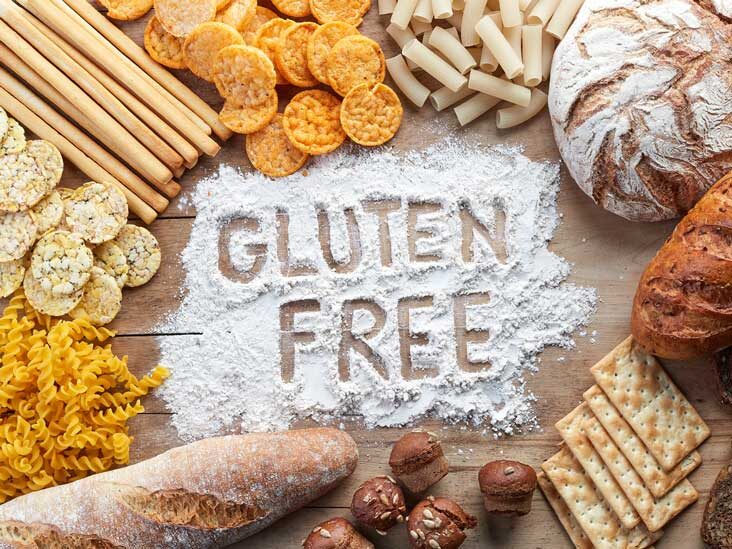What is Gluten?
Gluten is a composite of the proteins gliadin and glutenin. These exist, conjoined with starch, in the endosperms of some grass-related grains, notably wheat, rye, and barley. The following list of grains identifies which grains contain the highest amount of gluten. It is impossible to say exactly how much gluten they contain because of cross-contamination, genetic modification and variation in grains from one region to the next. The most common gluten-containing grains are Barley, Rye, Oat, Wheat & Spelt. You can easily remember them according to the acronym BROWS.
| Grain | Description | Gluten Level |
|---|---|---|
| Barley | Barley is the fourth most widely grown grain in the world. Barley flour is mostly used in Asia for bread baking. It is low in fat. It should be combined with bread or wheat flour. Use 1 part barley to 4 parts wheat or bread flour. | Very Low |
| Buckwheat | Buckwheat is not a true cereal grain. It is a seed and is related to rhubarb and sorrel. It is the most often used pancake. It is also known as Kasha. Look for buckwheat groats to make flour from. These are the seeds with minimal processing. It is high in protein and fiber. It is a discernible grassy flavor. Works well mixed with other grains like wheat. | None |
| Corn | Corn flour is more finely ground than cornmeal and both are derived from dent or flint corn — not sweet corn. Bread using cornflour or cornmeal has a crunchy, crumbly texture and pleasing sweetish taste. | None |
| Wheat | Wheat is very old. When ground fresh it contains all of the B vitamins (except B12). It also contains various other vitamins, minerals, fiber and enzymes. | High |
| Rye | Rye is one of the stronger tasting grains. This is because of its weed-like behavior. Rye works best in unleavened baked goods or in combination with whole-wheat flour. | Low |
| Kamut | Kamut is an ancient Egyptian form of wheat. It is related to modern durum (pasta) wheat, Kamut has a rich and buttery flavor. It is also well-tolerated by many who are sensitive to wheat. It is also a highly nutritional grain. | High |
| Quinoa | Quinoa is an Incan grain. Quinoa is often called a “super grain” because it supplies nearly twice the protein of most grains. Quinoa has a unique flavor. However, it is one of the more expensive grains | None |
| Spelt | Spelt can be used like wheat, but it has a nuttier taste. It also is lacking wheat’s allergenic properties. What this means is that people that are wheat sensitive find they can easily tolerate spelt. | High |
| Rice | Rice is the most widely consumed staple food in the world. When it is natural unrefined state rice is a nutritious grain with a nutty flavor and slight crunch. Always use brown rice, white rice is of little nutritional value | None |
| Millet | Millet is small and round. It is mostly used in birdseed. It is a good source of protein, superior to that of wheat, corn, or rice. Millet can also be popped, roasted, sprouted or malted. | None |
| Oat Groats | Unlike most grains, only the inedible hill of oats is removed in the milling process. The bran and the germ remain in the edible portion; know as the groat, making oats a good source of protein, fiber, and many nutrients. Oats are a cancer fighter. | None |
| Steel-Cut Oats | These are the least refined type of oats and are produced by slicing the oats. Oats are a cancer fighter. | None |
| Amaranth | Amaranth is high in protein, calcium, iron, and phosphorus. Use Amaranth in small amounts — about one part amaranth flour to 4 parts wheat or bread flour. It has a nutty, earthy flavor. | None |
Why Is Gluten Bad For Me?
Gluten can be bad for several reasons. If you have celiac disease, gluten causes an immune reaction in the body that can lead to intestinal damage and consequently impaired digestion such as the absorption of important nutrients. Other people can have a sensitivity to gluten without having celiac disease. For these people, the high amounts of gluten in North American grains makes it difficult for the body to recognize and digest gluten. This in turn leads to inflammation in the digestive system leading to symptoms such as pain, constipation, diarrhea, or non-digestive symptoms such as acne, eczema or a runny nose.
Hidden Sources of Gluten
- Hydrolyzed Plant Protein or Hydrolyzed Vegetable Protein (HPP or HVP) – maybe corn or wheat-based
- Modified Food Starch - Often Modified Wheat Starch.
- Natural and/or Artificial Flavorings - Sometimes hydrolyzed protein may be used for flavoring, and sometimes barley, malt or rye derivatives are used for flavoring.
- Starches - Often used as binding agents and thickeners in seasonings.
- Dextrin - also used as a thickener, dextrin can be made of corn, rice, tapioca, wheat or potato. If wheat is used, it should be identified as Wheat Dextrin
- Individual spices - Individual spices won't contain gluten, but a mixture might carry wheat starch as a binding agent. It will be noted on the label.
- Also watch for things such as vodka and any liquor made from gluten-containing grains, thick soups (such as chowder or bisque thickened with flour), gravy, malt vinegar
Kitchen Tips
- Keep your gluten-free food in a separate Kitchen space
- Prepare gluten-free foods first
- Use separate or thoroughly washed utensils
- Thoroughly clean kitchen items that touch gluten products such as toasters before using them with gluten-free products
Shopping Suggestions
- Read labels. Manufacturers and store clerks are notoriously misinformed about what is and are not gluten-free
- Avoid bulk stores where cross-contamination in the air and with scoops is common
- Note that deli meats, spice combinations and any products such as pre-made burger and crab cakes often contain gluten and wheat as a binding agent.
- Check your beauty products, wheat germ oil can cause skin reactions for some people.



